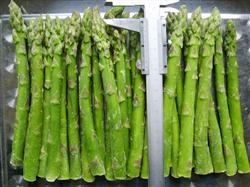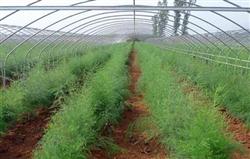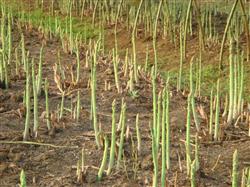How can asparagus be planted with high yield?

How can asparagus be planted with high yield? Asparagus, also known as asparagus, high-grade nutrition and health vegetables, known as "king of vegetables" and "one of the top ten famous dishes in the world", can be processed into canned and nutritious products, and it is a "gold industry" for export to earn foreign exchange. The market is tight and the price is high. Asparagus is a perennial crop, which can be harvested for 10-15 years at a time, and can be planted from March to October. High economic benefits can be obtained by using scientific management, so vigorously popularizing the cultivation of asparagus is a good way for farmers to get rich. 1. Variety selection according to the requirements of asparagus production, asparagus varieties should have the characteristics of dark green color, tight tip, good shape of tender stem, not easy to bend, less deformity and strong resistance to diseases and insect pests. All localities should select asparagus varieties suitable for local cultivation according to local conditions. 2. Seed sowing is used in large area cultivation, and the suitable sowing period is calculated according to the standard of asparagus growth from May to June. Spring sowing seedlings in protected field sowed in late February, open field sowing in April, autumn sowing in August-September. The nursery should choose sandy soil with convenient irrigation and drainage and good ventilation. 1500-2000 kg of rotten barnyard manure is applied to the nursery, and then ploughed into the soil, 10 kg of urea, 16 kg of calcium superphosphate and 10 kg of potassium chloride are added into the soil and fully mixed with the soil to make a seedbed 1.2-1.5m wide, with a horizontal sowing ditch every 40 cm, 2 cm deep. Sow 1 seed every 7-10 cm, cover 2 cm thick soil layer, cover the border with straw, fully water, keep wet, and then cover with a small arch shed. Sow seeds 500-600 grams per mu of seedling bed. When the seedling height is 7-10 cm, 3.5 kg of urea and 2.5 kg of potassium chloride are applied per mu, diluted with water, ditched or burrowed, and fertilized every 10 days. The seedling stage should be regularly sprayed with 0.3% murine 0.5% Bordeaux solution and 70% methyl mop 1000 times solution to prevent diseases, and timely ploughing and weeding. 3. Cultivation key points: deep ploughing the field before planting in the field, applying 3000 kg of rotten heap barnyard manure per mu, turning into the soil, making the border after the ground is leveled, digging the planting ditch in the middle of the border, the ditch is 30-40 cm deep and 50-60 cm wide. 2000 kg of barnyard manure, 30 kg of calcium superphosphate, 7 kg of urea and 10 kg of potassium chloride are applied to each mu of the planting ditch. It is planted in spring or autumn with a distance of 30-40 cm. When planting, make the root system stretch, cover the soil 5-6 cm, pat and water it, cover the soil again after survival, and fill the planting ditch. 4. rational fertilization follows the principle of "giving priority to farm manure and organic-inorganic combination". During the annual growth period, asparagus should apply 4000-5000 kg of rotten farm manure, 22 kg of pure nitrogen, 18 kg of pure phosphorus and 18 kg of pure potassium per mu of asparagus. It is strictly forbidden to use immature farm manure, and it is best to apply biological fertilizer when there are conditions. the fertilizer is divided into three times a year, the first budding fertilizer, and the first sprouting fertilizer before picking bamboo shoots at the end of March. N ∶ P ∶ K is 5 ∶ 3 ∶ 2, accounting for 20% of the total amount of fertilizer applied in the annual growth period: the second compound fertilizer is carried out after bamboo shoot harvesting in May-June, N ∶ P ∶ K is 5 ∶ 4 ∶ 4, accounting for 60% of the annual growth period, and the third autumn compound fertilizer is carried out after the Beginning of Autumn in August, and N ∶ P ∶ K is 3 ∶ 3 ∶ 4. 5. Timely irrigated asparagus is a crop that likes temperature, tolerance and fear of waterlogging. It is planted in the arid land of the Loess Plateau. It should be watered in time in order to maintain soil moisture. The general annual growth period needs to be watered 6 times, before ridges in March, in the middle of bamboo shoots, after ridges, in dog days, after autumn, and during overwintering. 6. Manual or mechanical weeding is used for weeding in the middle ploughing. It is forbidden to use all kinds of herbicides. After each irrigation, the soil moisture is preserved and the soil is ploughed once in time, so as to keep the soil near the rhizosphere of the plant loose and free from cracks, increase ventilation and reduce evaporation. 7. The prevention and control of diseases and insect pests should adhere to the principle of "prevention first and comprehensive control", strengthen the coordination and matching of agricultural, biological, physical and chemical control, and strictly control the application of chemical pesticides. Asparagus mainly has fungal diseases such as stem blight, root rot, brown spot and so on. the main pesticides are biological pesticides (agricultural resistance 120) and mineral pesticides (stone-sulfur mixture, Bordeaux liquid). Chemical pesticides must select varieties with high efficiency, low toxicity and low residues, such as carbendazim, Baike and other national green food pesticides allowed to be used. Before the advent of high temperature and humidity from June to August, it is the key period for disease prevention of asparagus. With the different stems of asparagus in the field, timely spraying can achieve a good prevention effect. Click to get more asparagus planting techniques click to get more vegetable planting techniques
- Prev

How can asparagus be managed to produce high yield?
How can asparagus be managed to produce high yield? Please guide asparagus cultivation to high yield can refer to the following methods of management: first, to cultivate strong seedlings to obtain high yield of asparagus, in addition to selecting good varieties, it is also necessary to establish a nursery for seedling raising. The most suitable nursery period is June, and the seedling raising time is about 3 months. The row spacing of the plant is 16.5 cm ×.
- Next

What are the techniques for growing asparagus?
What are the techniques for growing asparagus? Please introduce asparagus cultivation can refer to the following techniques: soil preparation and fertilization. Select sandy loam soil with sunny ventilation, deep soil layer, low groundwater level, pH 6-6.7 and good permeability, and the previous stubble should not be fast in mulberry orchards, orchards, rice, tomatoes and so on. Turn the land 30cm to 40cm deep.
Related
- Where is it suitable to grow horseradish in China? it is expected to see the middle altitude horseradish in Alishan.
- How to prevent tomato virus disease reasonably? (Control methods included)
- Many people like to plant towel gourd on the balcony. What are the main points of this method and management?
- What crops can chili peppers be mixed with?
- Fertilization techniques and matters needing attention in Tomato
- What are the grafting techniques for peach seedlings in spring?
- Harm and control methods of root swelling disease of Chinese cabbage
- What are the pests of sweet potatoes? How to prevent and cure it?
- Symptoms, causes and Control methods of navel Rot in Tomato
- The cause of "Cucumber rotten bibcock" in Farmers' planting Cucumber and its Control Plan

